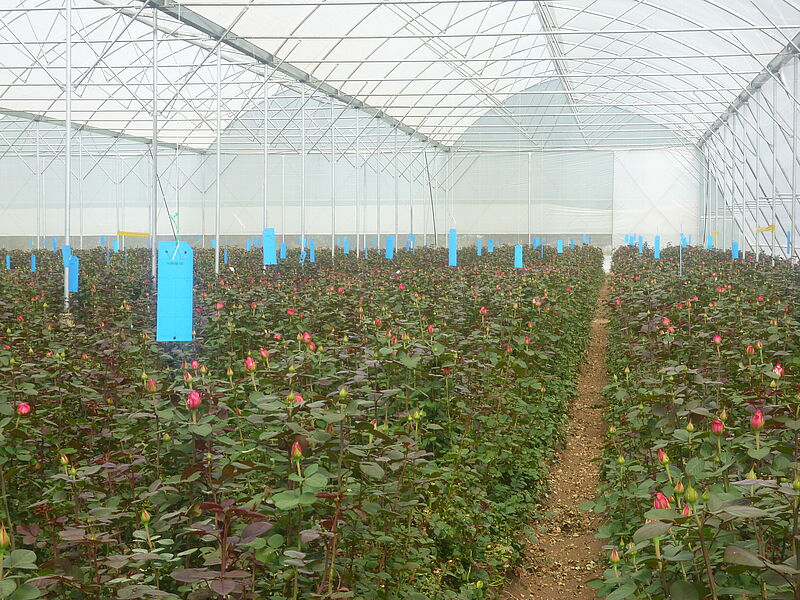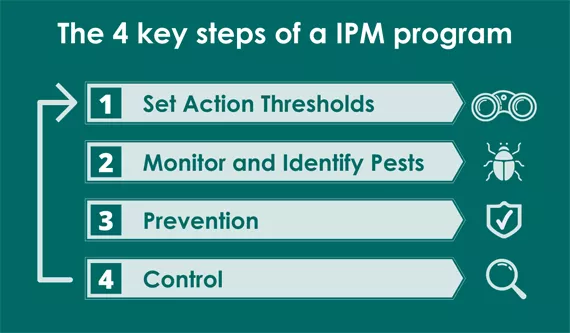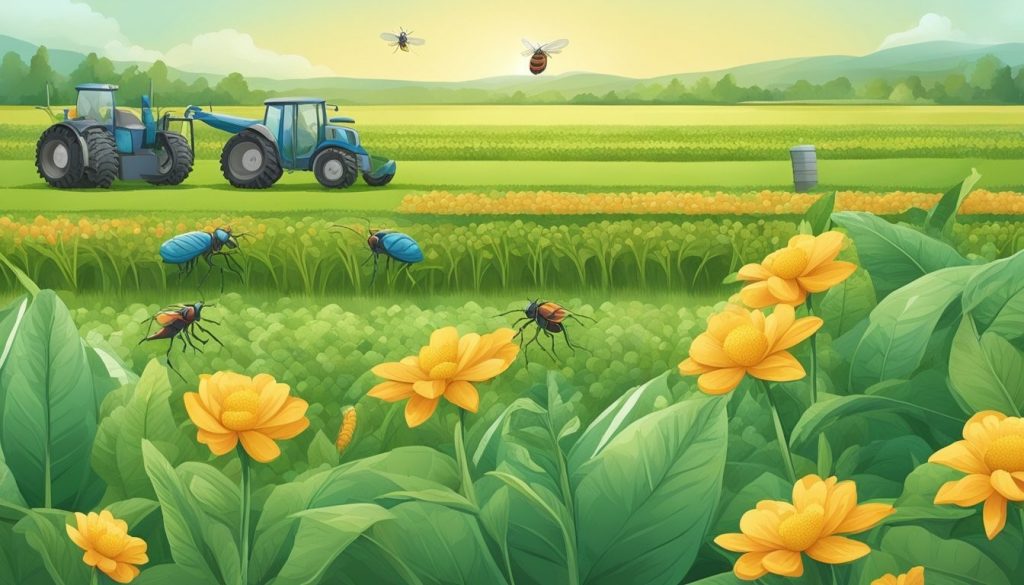Key Strategies for Effective Crop Management

Establishing action thresholds is a crucial first step. Action thresholds are specific levels of pest populations or damage that, when reached, warrant control measures to prevent economic losses, health hazards, or unacceptable nuisances. Integrated Pest Management (IPM) is a method that prioritizes the use of action thresholds, emphasizing regular monitoring and combining biological, cultural, and chemical control tactics to maintain pest densities at acceptable levels.
Monitoring pests effectively under an IPM strategy involves assessing pest presence and quantifying their impact on crops, landscapes, structures, or human health. Professionals in pest management engage in constant surveillance, employing various techniques to track pest populations and their dynamics. The decision to intervene—and the method chosen—is guided by the compiled data, with strategies aiming to be reactive to current conditions but also proactive to prevent future issues.
The integration of various control methods in IPM allows for a sustainable approach to managing pests. Through careful monitoring and the setting of precise action thresholds, pest control actions are optimized for efficacy and minimize unnecessary disruptions to ecosystems. The ultimate goal of IPM is to reduce reliance on chemical pesticides, therefore lessening the environmental footprint while effectively addressing pest concerns.
Fundamentals of Pest Thresholds
In pest management, understanding and implementing pest thresholds is critical for taking timely and effective action to minimize damage and maintain control costs.
Action thresholds are predetermined levels at which pest populations or environmental conditions indicate that pest control action must be taken to prevent an unacceptable level of damage. They serve as a trigger for implementing pest control methods, ensuring that interventions are made before pests become a significant economic threat or risk to the crop, property, or environment. These thresholds are set by monitoring and assessing pest presence against environmental conditions, considering factors such as the type of crop, pest behavior, and prevailing weather patterns.
Establishing Economic Thresholds
Economic thresholds are closely tied to action thresholds but focus specifically on the financial aspect of pest control. An economic threshold is the point at which the cost of pest damage exceeds the cost of managing the pest population. Determining this threshold involves rigorous monitoring of pest populations, analyzing the potential risk to the crop or environment, and projecting the economic impact based on current and forecasted agricultural market values. Establishing economic thresholds is especially important in agricultural settings, where the balance between input costs and potential harvest yield is finely tuned, but it’s also applicable in non-agricultural scenarios, where the focus may be on preventing health hazards or property damage. Employing an environmentally sensitive approach to pest management starts with establishing sound economic thresholds to inform an integrated pest management strategy.
Concepts of Integrated Pest Management (IPM)
Integrated Pest Management, or IPM, is a comprehensive approach combining various environmentally sensitive and common-sense practices for effective pest control. This method relies on a thorough understanding of pests and their interaction with the environment to manage pest populations at acceptable levels.
Principles of IPM
IPM is grounded in several key principles that prioritize environmental health and efficient pest control. Firstly, monitoring is essential; regular observation and identification of the pest population is necessary to make informed decisions. Employing beneficial organisms that naturally control pests is another cornerstone of IPM, enhancing natural pest management without chemicals. Crucially, IPM aims to select and implement pest-resistant varieties of plants and other environmentally sensitive control methods to minimize adverse effects on non-target organisms and reduce reliance on chemical pesticides.

IPM in Agricultural Settings
In agricultural contexts, IPM strategies include selecting pest-resistant varieties and altering planting times or patterns to outwit pests. Utilizing IPM-grown products often fosters an environmentally sensitive approach to agriculture. These practices do not aim for the total elimination of pests but rather to manage them to prevent economic damage and maintain the beneficial organisms within the ecosystem. Monitoring and maintaining action thresholds ensure that pest control methods are only applied when necessary, which is crucial for sustainable agriculture.
IPM for Non-Agricultural Spaces
For non-agricultural areas such as public spaces and storage areas, IPM emphasizes the importance of prevention by design—for example, using structural barriers and proper sanitation to deter invasions. It incorporates monitoring to determine if and when pest populations are reaching unacceptable levels and deciding on the most appropriate, environmentally sensitive management strategy. Whether in homes, offices, or public gardens, IPM focuses on creating an inhospitable environment for pests while minimizing impact on humans, animals, and the environment.
Pest Identification Techniques
Accurate pest identification is paramount to implementing effective control strategies. Some techniques include:
- Microscopic examination to identify pests down to species level, which is necessary for understanding their behavior, lifecycle, and the potential threat they pose.
- Using field guides or consulting with experts to recognize various types of pests and distinguish them from non-target organisms, thus ensuring that beneficial insects or natural enemies are preserved.
Proper identification informs the choice of intervention and helps prevent unnecessary or misdirected control efforts that might harm the environment or non-target species.
Biological and Environmental Monitoring
Monitoring goes beyond mere detection; it includes documenting the environment and understanding the natural sources that may attract or sustain pests:
- Biological monitoring involves scouting for pests and also looking for their natural enemies in the ecosystem, maintaining a balance where possible.
- Environmental monitoring includes assessment of the surrounding conditions that might affect pest populations, such as moisture levels, temperature, and habitat structures.
These practices help in predicting pest outbreaks and aid in the development of thresholds. The use of environmental data enables a more anticipatory approach to pest management, rather than a purely reactive one.
Pest Control Strategies
Effective pest management hinges on applying a combination of methods tailored to the specific pest scenario. By integrating cultural, chemical, and biological strategies, pest control can be both more effective and more sustainable.
Cultural Control
Cultural methods are fundamental in reducing the dependency on pesticides by modifying the environment to make it less conducive to pest proliferation. By manipulating factors such as water availability, shelter, and host plants, these methods aim to disrupt the normal life cycle and behavior of pests. Implementing pest-free rootstock and altering planting schedules are examples of cultural practices that help manage pest populations without chemicals.
Chemical Control Approaches
Chemical control should be used judiciously and as part of an environmental stewardship program. When treatment is necessary, targeted spraying of pesticides is often preferred over broadcast spraying to minimize environmental impact and preserve natural enemies of pests. Treatment thresholds help determine the right time for pesticide application. Pesticides include both synthetic chemicals and biopesticides, the latter being derived from natural materials like microorganisms, plants, and minerals.
Biological Pest Management
Biological pest management leverages natural enemies to control pest populations. This approach involves introducing or conserving predators, parasites, or pathogens that specifically target pests. It is a cornerstone of sustainable pest management as it helps reduce reliance on chemical interventions. Implementing biological control must be based on a thorough understanding of the pest and its interaction with other species within the ecosystem.
Preventive Measures and Action Planning
Effective pest management strategies focus on prevention as the first line of defense against pests. By implementing proactive measures, one can significantly reduce the need for reactive treatments. This approach involves environmental modifications and strict sanitation practices to create conditions that are less attractive to pests.
Environmental and Habitat Alterations
One can reduce pest incursions by altering their environment to make it less hospitable. Garden planning plays a crucial role in this, as certain plant selections and placements can deter pests naturally. Another key aspect is weatherization; sealing gaps and fixing cracks in a building’s exterior prevents pests from entering. Maintaining the property to prevent standing water also helps inhibit mosquito breeding sites.
- Key Strategies:
- Plant pest-resistant plant varieties.
- Introduce natural pest predators.
- Remove debris and weeds that may harbor pests.
- Use proper drainage to eliminate standing water.
Pest-Proofing and Sanitation
Pest-proofing and maintaining high levels of sanitation in critical areas are essential to prevent infestations. Well-trained staff play an important role in executing these measures effectively.
Pest Management Evaluation and Report
In pest management, the efficacy of control strategies is measured through thorough evaluations and comprehensive reports. This process encompasses assessing pest populations and the cost-efficiency of action taken, as well as documenting findings to refine future strategies.

Assessment and Decision Making
Assessment in pest management involves monitoring pest populations to determine the presence and severity of an infestation. Pest management evaluations utilize set action thresholds to decide when it is necessary to implement control measures. This ensures that appropriate control decisions are made, balancing cost-efficiency with environmental considerations. For example, an action threshold may indicate a pest density that threatens economic damage, necessitating intervention.
Documentation and Continuous Improvement
Documentation is a critical component of the pest management continuum. It involves creating detailed reports that cover the specifics of monitoring results, actions taken, and their outcomes. These reports serve as a basis for review, offering insights into the success of the chosen pest control methods. By maintaining accurate records, pest management can evolve into a more precise science, with a clear log of past actions fostering a cycle of continuous improvement. An effective report may include tables displaying pest counts before and after interventions, costs involved, and notes on environmental impact.
Implementing Pest Thresholds and IPM
Implementing pest thresholds within an Integrated Pest Management (IPM) plan involves careful monitoring and specific actions at predetermined levels of pest activity. Accurate monitoring systems and a keen understanding of pest tolerance are crucial for environmentally sensitive and potentially organic practices.
Generating IPM Plans
An IPM plan is a strategic guide that prioritizes sustainable pest management tactics. These plans are tailored to specific situations, taking into account the types of pests, the environment affected, and the acceptable limits of pest activity, also known as thresholds. A comprehensive plan defines action thresholds, the point at which pest numbers justify the implementation of control methods to prevent significant damage or economic loss. Integrated Pest Management (IPM) Principles outlines this fundamental step.
Setting up Monitoring Systems
Monitoring pests is essential for timely and effective IPM. Implementing robust monitoring systems can include insect traps, regular scouting by trained individuals, and the use of decision-support tools that predict pest population growth. For example, in agriculture, insect monitoring techniques can help determine the need for interventions, which are grounded in the IPM plan’s action thresholds.
Pest Tolerance and Environmental Considerations
Pest tolerance levels vary depending on the crop or environment and the goals of the pest management strategy. An environmentally sensitive approach, often adopted by organic systems, requires a detailed understanding of both the pest and the ecosystem. Such approaches emphasize prevention, the use of non-chemical control methods where possible, and interventions only when pests exceed tolerance levels, ensuring minimal impact on the environment.
Special Considerations in Pest Management
In the realm of pest management, it’s essential to consider the direct impact on public health and safety, address specific pest challenges effectively, and incorporate advanced techniques into pest management strategies. These facets are crucial for food production, growers, and ensuring that pest control measures remain innocuous.
Addressing Specific Pest Issues
Each pest poses a unique set of challenges that must be carefully addressed. Growers must be vigilant in monitoring pest populations and employ targeted pest control measures that address specific pests. This specificity helps ensure effectiveness and mitigates unnecessary applications of pesticides that might affect the broader ecosystem or the marketplace.
Advanced Techniques in Pest Management
The incorporation of advanced techniques can significantly enhance the effectiveness of pest management strategies. The use of pheromones, for instance, can provide precise monitoring and control of pest populations by disrupting their mating patterns or attracting them to traps. These techniques enable growers and pest management professionals to implement more focused and environmentally sensitive approaches, ensuring that interventions are not only more effective but also minimize negative impacts on the environment and non-target species.
